|
|
|
Sort Order |
|
|
|
Items / Page
|
|
|
|
|
|
|
| Srl | Item |
| 1 |
ID:
090065
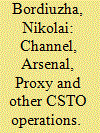

|
|
|
|
|
| Publication |
2009.
|
| Summary/Abstract |
The Organization provides an effective format for active joint efforts in countering drug trafficking, illegal migration, organized crime, and other outstanding problems. Effective mechanisms have been created to coordinate national efforts - e.g., CSTO auxiliary bodies comprising the heads of relevant national agencies, coordination councils on countering drug trafficking, illegal migration and emergency situations, as well as working groups of experts as part of the Security Council Secretaries Committee on matters of IT and security policy, and the fight against terrorism and extremism.
|
|
|
|
|
|
|
|
|
|
|
|
|
|
|
|
| 2 |
ID:
143779
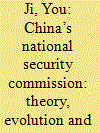

|
|
|
|
|
| Summary/Abstract |
The establishment of the National Security Commission (NSC) of the Chinese Communist Party (CCP) is a major regrouping of the top CCP power structure, a ‘New Deal’ in Xi Jinping’s endeavor to revitalize China. In full operation it will reshape Beijing’s national security (NS) decision-making process concerning the formulation of national security strategies, crisis management at home and abroad, coordination of national security policies and actions by Party/army/state agencies and institutional links with its foreign national security counterparts. This article argues that the NSC will primarily address the Party’s internal security concerns, which is the key link to its efforts to strike a new balance between various security typologies. It analyses Beijing’s securitization guidance and practice and constructs its organizational structure and functions.
|
|
|
|
|
|
|
|
|
|
|
|
|
|
|
|
| 3 |
ID:
170941
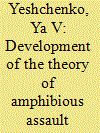

|
|
|
|
|
| Summary/Abstract |
This paper examines the practice of conducting amphibious assault operations during the Civil War in light of increasingly topical defense of the Crimea, Azov, and the Black Sea shores of Russia, and also the effect of the small war theory on the formation and development of military theory views of amphibious assault operations in the interwar period (1922-1941)
|
|
|
|
|
|
|
|
|
|
|
|
|
|
|
|
| 4 |
ID:
168433
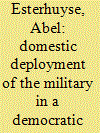

|
|
|
|
|
| Summary/Abstract |
The paper aims at providing a brief analysis on key realities underpinning the debate on the domestic deployment of the South African armed forces. The theoretical analysis highlights the divergent reality of shrinking budgets and capabilities, and a growing operational schedule confronting militaries in the contemporary era. This is exacerbated by a threat agenda that necessitates armed forces to downscale and police forces to upscale in order to address a threat reality that is neither predominantly external nor exclusively internal in nature. The South African military is fortunate to have access to a long history of domestic deployment that suggests key guidelines for future thinking about internal deployments. The revival of internal military deployment will confront the South African Defence Force (SANDF) with critical trade-offs in decisions about distribution of its resources, sustaining current internal and external deployments, command and control structures, facilities, and key personnel and equipment deficiencies. Routine participation in internal operations, in effect, implies a re-invention of defence policy and SANDF strategies for force development, force deployment, and force employment.
|
|
|
|
|
|
|
|
|
|
|
|
|
|
|
|
| 5 |
ID:
133316
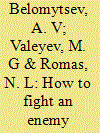

|
|
|
|
|
| Publication |
2014.
|
| Summary/Abstract |
The authors discussed the specifics of fighting against an enemy attacking from aerospace with focus on significant differences in the actions taken by the friendly aerospace defence forces and the weapons they use in comparison with those of the strike (attacking) forces, and express their views on the best ways of using these elements of the Russian Armed Forces in one form or another.
|
|
|
|
|
|
|
|
|
|
|
|
|
|
|
|
| 6 |
ID:
087197
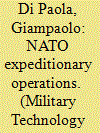

|
|
|
|
|
| Publication |
2009.
|
| Summary/Abstract |
Military Technology spoke to Admiral Giampaolo Di Paola, former Chief of the Italian Defence Staff and current Chairman of Milirary Committee, NATO's highest military authority, about the current status and future-oriented prospects of the alliance's expeditionary posture.
|
|
|
|
|
|
|
|
|
|
|
|
|
|
|
|
| 7 |
ID:
171807
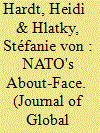

|
|
|
|
|
| Summary/Abstract |
Scholars in global security studies have only recently focused attention on how and why international security organizations (ISOs) adapt. Since the United Nations Security Council's issuance of Resolution 1325, some ISOs have enacted changes to implement gender mainstreaming. The concept involves incorporating gender-based analyses in policy and planning and increasing women's representation. Drawing on interviews with seventy-one elites and a dataset of ninety-seven NATO gender guidelines, this article introduces an original argument for why NATO adapted to gender mainstreaming. Such adaptation is surprising given the military's historical resistance to gender considerations and that civilian bodies typically enact reforms. Findings indicate that other ISOs were substantially influential in the process and that institutional incentives built into NATO's military bodies drove military officials to implement mainstreaming in practice. Additionally, military elites perceived a link between gender mainstreaming and operational effectiveness, which further consolidated organization-wide adaptation. This study challenges long-held assumptions about militaries’ resistance to gender-related changes. It also offers one of the first empirical assessments of gender mainstreaming in an ISO.
|
|
|
|
|
|
|
|
|
|
|
|
|
|
|
|
| 8 |
ID:
107773
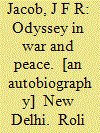

|
|
|
|
|
| Publication |
New Delhi, Roli Books, 2011.
|
| Description |
x, 189p.Hbk
|
| Standard Number |
9788174368409
|
|
|
|
|
|
|
|
|
|
|
|
Copies: C:1/I:0,R:0,Q:0
Circulation
| Accession# | Call# | Current Location | Status | Policy | Location |
| 056266 | 923.5/JAC 056266 | Main | On Shelf | General | |
|
|
|
|
| 9 |
ID:
150263
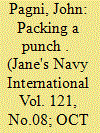

|
|
|
| 10 |
ID:
150223
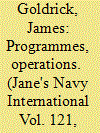

|
|
|
| 11 |
ID:
152402
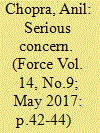

|
|
|
| 12 |
ID:
165356
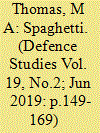

|
|
|
|
|
| Summary/Abstract |
In the mid-2000s, the United States Army was embroiled in counterinsurgency missions in Iraq and Afghanistan that required deeper understanding of local social systems. The Army turned to systems thinking and design thinking to model and understand the world, define problems, and develop approaches to strategic and operational challenges. However, the Army’s approach as expressed in publications and doctrine encourages the development of complicated, unsupported, and unfalsifiable hypotheses. The risk is that the Army will act on incorrect assumptions and develop plans that are fragile.
|
|
|
|
|
|
|
|
|
|
|
|
|
|
|
|
| 13 |
ID:
165097
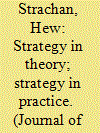

|
|
|
|
|
| Summary/Abstract |
The practice of strategy is different from strategic theory. The latter was largely developed by professional soldiers from the experiences of the Napoleonic Wars, and compared the present with the past to establish general truths about war. It used history as its dominant discipline until 1945. The advent of nuclear weapons made history seem less relevant, and prompted the inclusion of other disciplines; deterrence theory also made strategic theory more abstract and distant from the practice of war. Since 9/11, the experience of war has forced strategy to become less theoretical and to do better in reconciling theory with practice.
|
|
|
|
|
|
|
|
|
|
|
|
|
|
|
|
| 14 |
ID:
160267
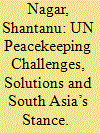

|
|
|
|
|
| Summary/Abstract |
The term peacekeeping is not included in the United Nations (UN) charter. The UN defines peacekeeping as ‘an operation involving military personnel, but without enforcement powers, established by the United Nations to help maintain or restore international peace and security in areas of conflict’ (White 1997). During the Cold War period, peacekeeping was mainly confined to Middle East, parts of Africa and other regional conflicts, which were mainly associated with de-colonisation. The major limitations are created when the states decline to offer forces for the peacekeeping operations, as is evident in the case of recent peacekeeping operations in Africa. The UN peacekeeping underwent a great expansion along with new mandates in the early part of 1990s. This resulted in a huge increase in the requirement of peacekeepers along with a rising budget and this led to a huge gap in terms of commitment and capability needed and what was provided. Greater number of resources including peacekeeping troops were required than what was actually made available. The two most egregious failures occurred in Srebrenica, Bosnia–Herzegovina, and in Rwanda. These failures have resulted in UN taking up several new measures in order to improve the peacekeeping operations. This article tries to highlight the impending governance issues of UN along with the adopted solutions to solve the issues. It also tries to highlight South Asia’s and India’s stance with respect to the UN peacekeeping operations and tries to argue that South Asian Nations should rethink its policy with respect to UN peacekeeping and adopt a smarter and more strategic approach towards its future engagement.
|
|
|
|
|
|
|
|
|
|
|
|
|
|
|
|
| 15 |
ID:
040479
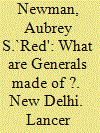

|
|
|
|
|
| Publication |
New Delhi, Lancer International, 1987.
|
| Description |
x, 314p.Hbk
|
| Standard Number |
817062102X
|
|
|
|
|
|
|
|
|
|
|
|
Copies: C:1/I:0,R:0,Q:0
Circulation
| Accession# | Call# | Current Location | Status | Policy | Location |
| 031748 | 923.573/NEW 031748 | Main | On Shelf | General | |
|
|
|
|
| 16 |
ID:
154703
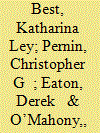

|
|
|
|
|
| Summary/Abstract |
US national security guidance, as well as the US Army’s operational experiences since 2001, emphasizes the importance of working closely with partner countries to achieve US strategic objectives. The US Army has introduced the global landpower network (GLN) concept as a means to integrate, sustain and advance the Army’s considerable ongoing efforts to meet US national security guidance. This study develops the GLN concept further, and addresses three questions. What benefits can the GLN provide the Army? What are the essential components of the GLN? What options exist for implementing the GLN concept? By developing the GLN concept, the Army has the opportunity to transition the GLN from an often ad hoc and reactive set of relationships to one that the Army more self-consciously prioritizes and leverages as a resource to meet US strategic objectives.
|
|
|
|
|
|
|
|
|
|
|
|
|
|
|
|
| 17 |
ID:
133174
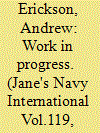

|
|
|
|
|
| Publication |
2014.
|
| Summary/Abstract |
Professor Andrew Erickson reviews China's strategic goals and the military capabilities it must master as it seeks to generate the strike power that is central to the effectiveness of a modern, advanced aircraft forces.
|
|
|
|
|
|
|
|
|
|
|
|
|
|
|
|
|
|
|
|
|